
|
acetic acid |
acetic acid is a lipid of Fatty Acyls (FA) class. Acetic acid is associated with abnormalities such as Vitamin B 12 Deficiency. The involved functions are known as Excretory function. The related lipids are Propionate. |
89633 |
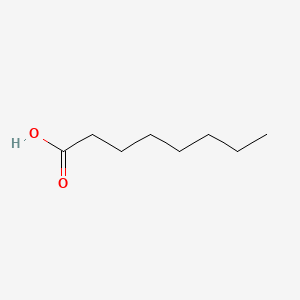
|
octanoic acid |
octanoic acid is a lipid of Fatty Acyls (FA) class. Octanoic acid is associated with abnormalities such as Ischemia, Diabetes Mellitus, Non-Insulin-Dependent, Diabetes, Cardiomyopathies and Obesity. The involved functions are known as Anabolism, 5-(carboxyamino)imidazole ribonucleotide mutase activity, Citric Acid Cycle, Metabolic Inhibition and Excretory function. Octanoic acid often locates in Pore, Protoplasm, Endothelium, Mitochondria and Muscle. The associated genes with octanoic acid are P4HTM gene, CPT1A gene, HADH gene, ACSL1 Gene and CD36 gene. The related lipids are Fatty Acids, Nonesterified Fatty Acids, Oleates, Palmitates and hexanoic acid. |
3349 |

|
Arachidonic acid |
Arachidonic acid is a lipid of Fatty Acyls (FA) class. Arachidonic acid is associated with abnormalities such as Atherosclerosis, Ischemia, Hypertensive disease, Hypertension induced by pregnancy and Vascular ring of aorta. The involved functions are known as Platelet aggregation, Anabolism, Ion Transport, Signal Transduction Pathways and Signal. Arachidonic acid often locates in Extracellular, Body tissue, Protoplasm, Tissue membrane and soluble. The associated genes with Arachidonic acid are CYP2J2 gene, CYP2E1 gene, Recombinant Proteins, POR gene and P4HTM gene. The related lipids are Fatty Acids, Glycerophospholipids, Steroids, octadecadienoic acid and 9-hydroxy-10,12-octadecadienoic acid. The related experimental models are Mouse Model and Knock-out. |
22864 |
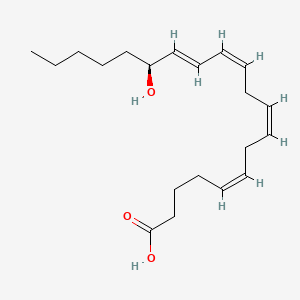
|
15S-HETE |
15s-hete is a lipid of Fatty Acyls (FA) class. 15s-hete is associated with abnormalities such as Ischemia and Vascular Diseases. The involved functions are known as Transcription, Genetic, Signal Transduction, tube formation, Angiogenic Process and Biochemical Pathway. 15s-hete often locates in Endothelium, Membrane, Cytoplasm, Body tissue and Protoplasm. The associated genes with 15S-HETE are RAC1 gene, ALOX15 gene, ALOX5 gene, Candidate Disease Gene and GAPDH gene. |
1011 |
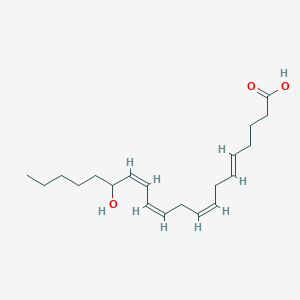
|
15-hete |
15-hete is a lipid of Fatty Acyls (FA) class. The involved functions are known as Inflammation, Signal Transduction, inhibitors, Obstruction and Adjudication. 15-hete often locates in Endothelium, Protoplasm, Cytoplasm, Cytoplasmic and Extracellular. |
725 |
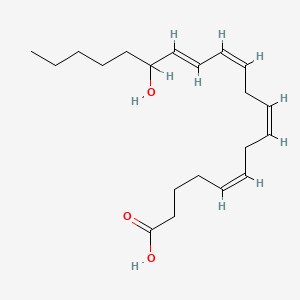
|
15-hete |
15-hete is a lipid of Fatty Acyls (FA) class. 15-hete is associated with abnormalities such as Endothelial dysfunction, Atherosclerosis, Risk factor, cardiovascular, hypercholesterolemia and Diabetes. The involved functions are known as uptake, Inflammation, Phosphorylation, Oxidation and Atherogenesis. 15-hete often locates in Endothelium, Cell surface, Protoplasm, Body tissue and Blood. The associated genes with 15-hete are CD36 gene, CCL2 gene, Orthologous Gene, SMAD2 gene and SMAD3 gene. The related lipids are 9-hydroxy-10,12-octadecadienoic acid and hydroxy fatty acid. |
725 |

|
Leukotriene b4 |
Leukotriene b4 is a lipid of Fatty Acyls (FA) class. The involved functions are known as Chemotaxis, release of sequestered calcium ion into cytoplasm and Polymerization. Leukotriene b4 often locates in Protoplasm. The associated genes with Leukotriene b4 are phallacidin. |
9311 |
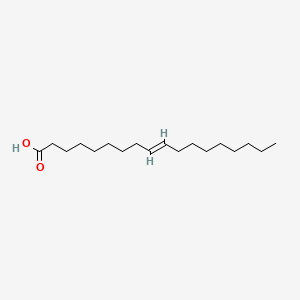
|
9-elaidic acid |
9-elaidic acid is a lipid of Fatty Acyls (FA) class. |
281 |

|
Linoleic acid |
Linoleic acid is a lipid of Fatty Acyls (FA) class. Linoleic acid is associated with abnormalities such as Diabetes Mellitus, Non-Insulin-Dependent, Metabolic syndrome, Obesity, Chronic Obstructive Airway Disease and Pneumonia. The involved functions are known as Insulin Resistance, Inflammation, Synthesis, Pathological accumulation of air in tissues and cytokine biosynthesis. The associated genes with Linoleic acid are TNF gene, CCL2 gene and TLR4 gene. The related lipids are palmitoleic acid, nervonic acid and Sphingolipids. |
5699 |

|
Linoelaidic acid |
Linoelaidic acid is a lipid of Fatty Acyls (FA) class. Linoelaidic acid is associated with abnormalities such as Obesity, Diabetes Mellitus, Non-Insulin-Dependent, Pneumonia, Chronic Obstructive Airway Disease and Metabolic syndrome. The involved functions are known as Metabolic Inhibition, Steroid biosynthesis, Signal Transduction, Insulin Resistance and Inflammation. Linoelaidic acid often locates in Mitochondria, Membrane and Cytoplasmic matrix. The associated genes with Linoelaidic acid are FFAR1 gene, C9orf7 gene, TNF gene, CCL2 gene and TLR4 gene. The related lipids are Fatty Acids, octadecadienoic acid, Steroids, methyl linoleate and Cyanoketone. |
10058 |
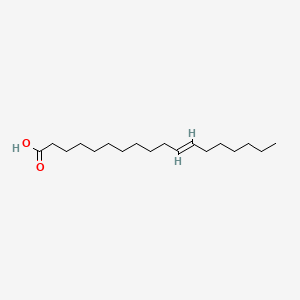
|
trans-vaccenic acid |
Trans-vaccenic acid is a lipid of Fatty Acyls (FA) class. |
341 |
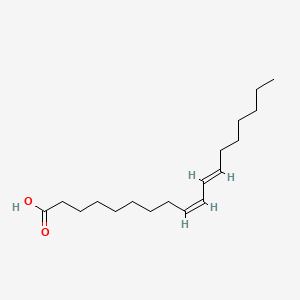
|
Rumenic acid |
Rumenic acid is a lipid of Fatty Acyls (FA) class. Rumenic acid is associated with abnormalities such as Atherosclerosis, Vascular lesions, Hyperlipidemia and Consumption-archaic term for TB. The involved functions are known as Fatty streaks, Transcriptional Activation, Atherogenesis, cholesterol transport and ATP binding. Rumenic acid often locates in Blood and Body tissue. The associated genes with Rumenic acid are ABCA1 gene, apolipoprotein SAA, FATE1 gene and TFCP2 gene. The related lipids are 9,11-linoleic acid, (E,Z)-isomer, 9,11-linoleic acid, Fatty Acids, 11-octadecenoic acid and Total cholesterol. |
324 |
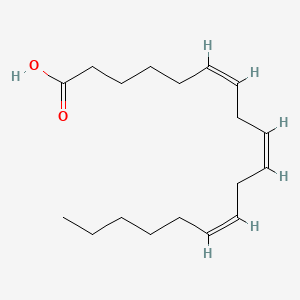
|
gamma-Linolenic acid |
Gamma-linolenic acid is a lipid of Fatty Acyls (FA) class. The involved functions are known as Drug Interactions. Gamma-linolenic acid often locates in Articular system. |
1919 |

|
alpha-linolenic acid |
Alpha-linolenic acid is a lipid of Fatty Acyls (FA) class. Alpha-linolenic acid is associated with abnormalities such as Coronary heart disease, abnormal fragmented structure, Arterial thrombosis and Subarachnoid Hemorrhage. The involved functions are known as Anabolism, Signal, Transcription, Genetic, Saturated and Regulation. Alpha-linolenic acid often locates in Blood, Body tissue, Plasma membrane, Hepatic and peroxisome. The associated genes with alpha-linolenic acid are FATE1 gene, volicitin, CYP2U1 gene, CYP1A2 gene and CYP2J2 gene. The related lipids are Fatty Acids, Dietary Fatty Acid, stearidonic acid and Fatty Acids, Nonesterified. |
4231 |
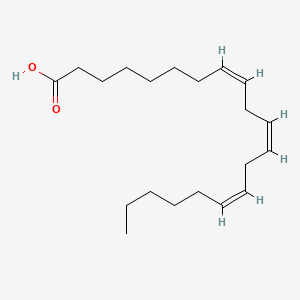
|
bishomo-gamma-linolenic acid |
Bishomo-gamma-linolenic acid is a lipid of Fatty Acyls (FA) class. Bishomo-gamma-linolenic acid is associated with abnormalities such as Diabetes, Obesity, Hypertensive disease, Cirrhosis and Hepatorenal Syndrome. The involved functions are known as Oxidation, Process, Metabolic Inhibition, epoxide hydrolase activity and Signal Transduction Pathways. Bishomo-gamma-linolenic acid often locates in Protoplasm, Cytoplasmic matrix, soluble, Membrane and Tissue membrane. The associated genes with bishomo-gamma-linolenic acid are P4HTM gene, IMPACT gene, arginine methyl ester, CYP gene and PTGS1 gene. The related lipids are Fatty Acids, 17-octadecynoic acid, Lipopolysaccharides, palmitoleic acid and nervonic acid. The related experimental models are Knock-out and Mouse Model. |
2467 |
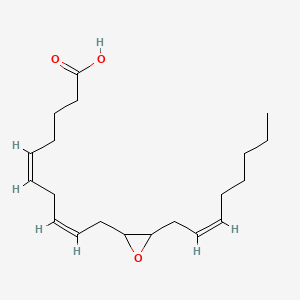
|
11,12-eet |
|
353 |
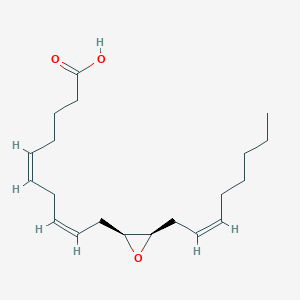
|
11s,12r-epetre |
11s,12r-epetre is a lipid of Fatty Acyls (FA) class. 11s,12r-epetre is associated with abnormalities such as Hypertensive disease, Coronary Arteriosclerosis, Atherosclerosis, Ischemia and Vascular Diseases. The involved functions are known as inhibitors, Pathological Dilatation, Renal function, depolarization and Force. 11s,12r-epetre often locates in Body tissue, Epithelium, Cell membrane, apical membrane and Endothelium. The associated genes with 11s,12r-epetre are CYP2C18 gene, ADRBK1 gene, iberiotoxin and TNF gene. |
353 |
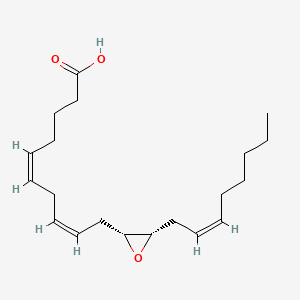
|
11r,12s-epetre |
11r,12s-epetre is a lipid of Fatty Acyls (FA) class. 11r,12s-epetre is associated with abnormalities such as Hypertensive disease, Coronary Arteriosclerosis, Atherosclerosis, Ischemia and Vascular Diseases. The involved functions are known as inhibitors, Pathological Dilatation, Renal function, depolarization and Force. 11r,12s-epetre often locates in Body tissue, Epithelium, Cell membrane, apical membrane and Endothelium. The associated genes with 11r,12s-epetre are CYP2C18 gene, ADRBK1 gene, iberiotoxin and TNF gene. |
353 |
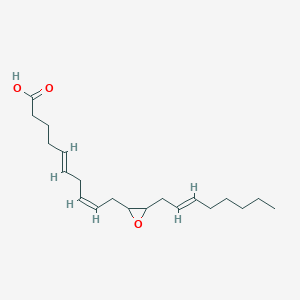
|
11,12-epetre |
|
136 |
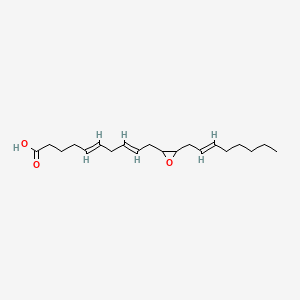
|
11,12-epoxyeicosatrienoic acid |
|
143 |
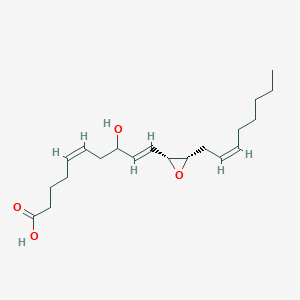
|
11,12-epoxy-8-hydroxyeicosa-5,9,14-trienoic acid |
11,12-epoxy-8-hydroxyeicosa-5,9,14-trienoic acid is a lipid of Fatty Acyls (FA) class. |
98 |
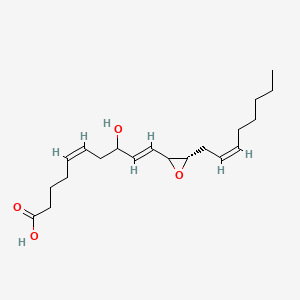
|
Hxa3 |
Hxa3 is a lipid of Fatty Acyls (FA) class. |
94 |

|
DHA |
Dha is a lipid of Fatty Acyls (FA) class. Dha is associated with abnormalities such as Atherosclerosis, Consumption-archaic term for TB, Chronic disease, Cardiovascular Diseases and Diabetes Mellitus, Non-Insulin-Dependent. The involved functions are known as Inflammation, Oxidation, fatty acid oxidation, Fatty Acid Metabolism and Lipid Metabolism. Dha often locates in Hepatic, Protoplasm, Mucous Membrane, Epithelium and outer membrane. The associated genes with DHA are IMPACT gene, FATE1 gene, GAPDH gene, THOC4 gene and SLC33A1 gene. The related lipids are stearidonic acid, Fatty Acids, Total cholesterol, Lipopolysaccharides and Dietary Fatty Acid. The related experimental models are Mouse Model, Transgenic Model, Animal Disease Models and Arthritis, Experimental. |
11054 |
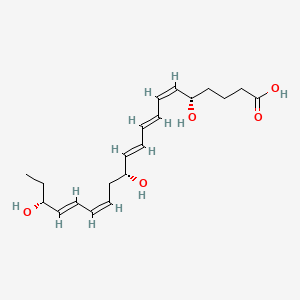
|
Resolvin e1 |
Resolvin e1 is a lipid of Fatty Acyls (FA) class. |
177 |
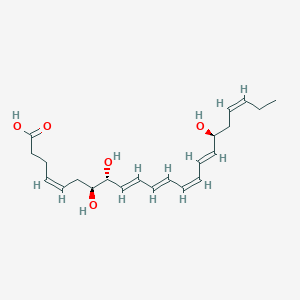
|
Resolvin d1 |
Resolvin d1 is a lipid of Fatty Acyls (FA) class. |
305 |
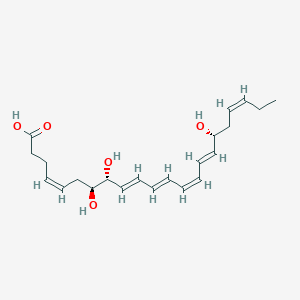
|
At-resolvin d1 |
At-resolvin d1 is a lipid of Fatty Acyls (FA) class. |
5 |
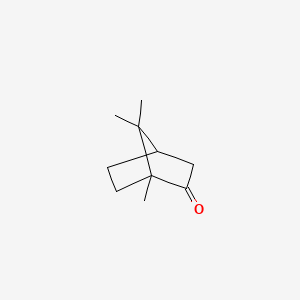
|
(+)-Camphor |
(+)-camphor is a lipid of Prenol Lipids (PR) class. (+)-camphor is associated with abnormalities such as Athetoid cerebral palsy. The involved functions are known as inhibitors, Synthesis, Feedback and Competitive inhibition. The associated genes with (+)-Camphor are 4S-limonene synthase. The related lipids are palmitoleic acid, pentadecanoic acid, stearic acid and erucic acid. |
3660 |
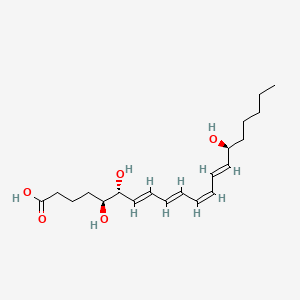
|
Lipoxin A4 |
Lipoxin a4 is a lipid of Fatty Acyls (FA) class. Lipoxin a4 is associated with abnormalities such as Asthma, Cystic Fibrosis, Pneumonia, Obesity and Septicemia. The involved functions are known as Inflammation, Signal, Signal Transduction, Regulation and Metabolic Inhibition. Lipoxin a4 often locates in Immune system, Blood, soluble, Extracellular and Splenic Tissue. The associated genes with Lipoxin A4 are FPR2 gene, Homologous Gene, SAA1 gene, Trp-Lys-Tyr-Met-Val-Met and Annexin 1. The related lipids are Steroids. The related experimental models are Knock-out. |
1240 |
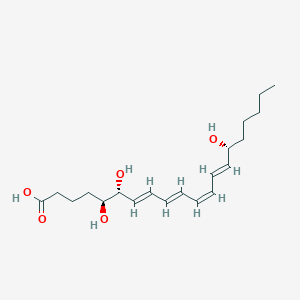
|
15-epi-lxa4;15r-lxa4 |
15-epi-lxa4;15r-lxa4 is a lipid of Fatty Acyls (FA) class. 15-epi-lxa4;15r-lxa4 is associated with abnormalities such as Pneumonia, Septicemia, Cystic Fibrosis, Subarachnoid Hemorrhage and Obesity. The involved functions are known as Protective Agents, Signal Transduction, cytokine biosynthesis, Inflammation and Anabolism. 15-epi-lxa4;15r-lxa4 often locates in Blood, Immune system and Heart tissue. The associated genes with 15-epi-lxa4;15r-lxa4 are IL2 gene, CXCL13 gene and CMKLR1 gene. The related lipids are Steroids. The related experimental models are Knock-out. |
305 |
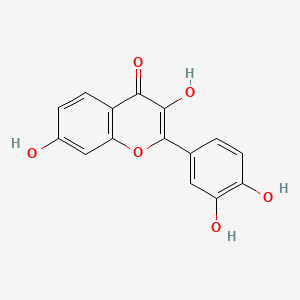
|
Fisetin |
Fisetin is a lipid of Polyketides (PK) class. Fisetin is associated with abnormalities such as Morphologically altered structure, PARKINSON DISEASE, LATE-ONSET, Tetanus, CNS disorder and Disintegration (morphologic abnormality). The involved functions are known as Autophagy, Apoptosis, Energy Metabolism, Acceleration and Anabolism. Fisetin often locates in Mitochondria, Cytoplasmic matrix, Extracellular, Cytoskeletal Filaments and Autophagic vacuole. The associated genes with Fisetin are SIRT1 gene, MAP1LC3A gene, TP53 gene, P4HTM gene and AURKB gene. The related lipids are Phosphatidylserines and Lipopolysaccharides. The related experimental models are Animal Cancer Model, Xenograft Model, Mouse Model, Cancer Model and Disease model. |
832 |

|
7-octadecynoic acid |
7-octadecynoic acid is a lipid of Fatty Acyls (FA) class. |
8379 |
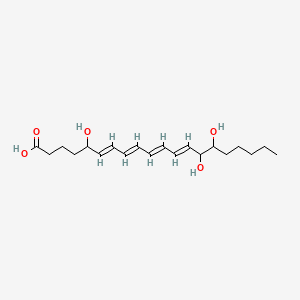
|
Lipoxin b |
Lipoxin b is a lipid of Fatty Acyls (FA) class. |
202 |

|
EPA |
Epa is a lipid of Fatty Acyls (FA) class. |
5952 |
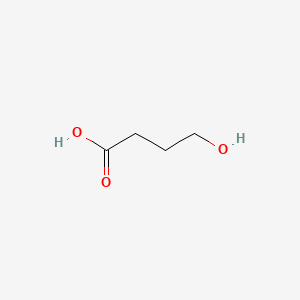
|
4-hydroxy-butyric acid |
4-hydroxy-butyric acid is a lipid of Fatty Acyls (FA) class. |
3927 |
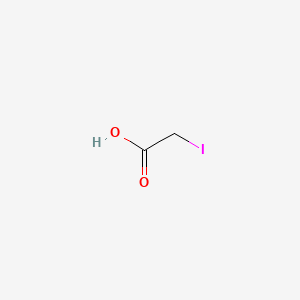
|
Iodoacetic acid |
Iodoacetic acid is a lipid of Fatty Acyls (FA) class. Iodoacetic acid is associated with abnormalities such as Photoreceptor degeneration and Post MI. The involved functions are known as Hypoxia, Glycolysis, Metabolic Inhibition, Oxidation and PTPS activity. Iodoacetic acid often locates in Extracellular, Muscle, Mitochondria, Cytoplasmic matrix and Tissue membrane. The associated genes with Iodoacetic acid are SLC33A1 gene, GTF2I gene, Mutant Proteins, TRIM33 gene and oxytocin, 1-desamino-(O-Et-Tyr)(2)-. |
3688 |

|
6-aminohexanoic acid |
6-aminohexanoic acid is a lipid of Fatty Acyls (FA) class. 6-aminohexanoic acid is associated with abnormalities such as Blood Clot, Myocardial Infarction, Cerebrovascular accident, Renal impairment and Scoliosis, unspecified. The involved functions are known as Fibrinolysis, Agent, Hemorrhage, plasminogen activation and inhibitors. 6-aminohexanoic acid often locates in Chest, Blood, Body tissue, peritoneal and Plasma membrane. The associated genes with 6-aminohexanoic acid are P4HTM gene, BSND gene, MTPN gene, NDUFS4 gene and Homologous Gene. The related lipids are Phosphatidylserines and Butyric Acid. |
3685 |

|
4-aminobutyric acid |
4-aminobutyric acid is a lipid of Fatty Acyls (FA) class. 4-aminobutyric acid is associated with abnormalities such as Epilepsy and Premenstrual syndrome. The involved functions are known as Binding (Molecular Function), neuron survival, Process, Uptake and physiological aspects. 4-aminobutyric acid often locates in Microglial, Neurofilament, Neuraxis, Brain region and Neurites. The associated genes with 4-aminobutyric acid are arginine methyl ester, SLC33A1 gene, NKS1 gene, P4HTM gene and ITSN2 gene. The related lipids are pregnenolone sulfate, pregnane-20-one, Pregnanes, Steroids and endogenous steroids. |
19702 |

|
2,5-diaminopentanoic acid |
2,5-diaminopentanoic acid is a lipid of Fatty Acyls (FA) class. The involved functions are known as Vasodilation, Intestinal Absorption and Pinocytosis. 2,5-diaminopentanoic acid often locates in Mitochondria, Microfilaments, NADH dehydrogenase complex and respiratory chain complex III location sensu Eukarya. The associated genes with 2,5-diaminopentanoic acid are GAPDH gene and iberiotoxin. |
8868 |

|
Lipoic acid |
Lipoic acid is a lipid of Fatty Acyls (FA) class. |
7940 |
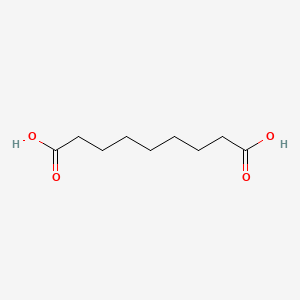
|
Azelaic acid |
Azelaic acid is a lipid of Fatty Acyls (FA) class. Azelaic acid is associated with abnormalities such as Bacterial Infections and Infection. The involved functions are known as Anabolism, Signal Transduction, Plant Immunity, Signal and Signal Transduction Pathways. Azelaic acid often locates in Body tissue. The associated genes with Azelaic acid are AZI1 gene, FKBPL gene and MLL gene. The related lipids are sebacic acid. |
783 |
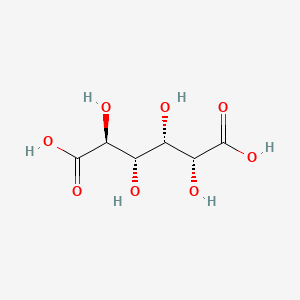
|
Glucaric acid |
Glucaric acid is a lipid of Fatty Acyls (FA) class. Glucaric acid is associated with abnormalities such as Consumption-archaic term for TB and furuncle. The involved functions are known as Oxidation, Mutation, Process, Cell Growth and Anabolism. Glucaric acid often locates in BL21, Clone and host. The associated genes with Glucaric acid are MIOX gene, ISYNA1 gene, Genome and Candidate Disease Gene. The related experimental models are Knock-out. |
1814 |

|
Prostaglandin E2 |
Prostaglandin E2 is a lipid of Fatty Acyls (FA) class. Prostaglandin e2 is associated with abnormalities such as Renal glomerular disease, Arthritis, Degenerative polyarthritis, Pancreatitis and Rheumatoid Arthritis. The involved functions are known as enzyme pathway, Atherogenesis, Anabolism, inhibitors and Oxidants. Prostaglandin e2 often locates in Tissue membrane, Blood, Extracellular, Membrane and Protoplasm. The associated genes with Prostaglandin E2 are PTGS2 gene, TP53 gene, TNFRSF5 gene, FASTK Gene and TNF gene. The related lipids are Lipopolysaccharides, Steroids, monooxyethylene trimethylolpropane tristearate, Fatty Acids, Unsaturated and Promega. The related experimental models are Arthritis, Adjuvant-Induced, Xenograft Model, Experimental Autoimmune Encephalomyelitis, Cancer Model and Knock-out. |
49278 |

|
PGD2 |
Pgd2 is a lipid of Fatty Acyls (FA) class. Pgd2 is associated with abnormalities such as Inflammatory disorder, Pleurisy, Rhinitis, Dehydration and Pneumonia. The involved functions are known as antagonists, fat cell differentiation, Phosphorylation, Process and Gene Expression. Pgd2 often locates in Cell surface, Body tissue, Extracellular, Bone Marrow and Membrane. The associated genes with PGD2 are oxytocin, 1-desamino-(O-Et-Tyr)(2)-, P4HTM gene, PTGS2 gene, PTGDS gene and IL3 gene. The related lipids are 15-deoxyprostaglandin J2, Nonesterified Fatty Acids, Lipopolysaccharides, Steroids and Liposomes. The related experimental models are Knock-out and Rodent Model. |
6464 |
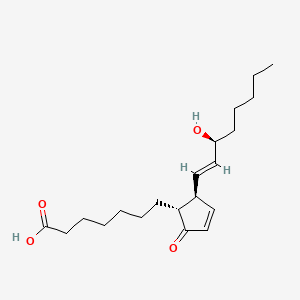
|
PGA1 |
Pga1 is a lipid of Fatty Acyls (FA) class. Pga1 is associated with abnormalities such as Hyperostosis, Diffuse Idiopathic Skeletal, Polyglandular Type I Autoimmune Syndrome and Infection. The involved functions are known as Uptake, inhibitors, Binding (Molecular Function), Denaturation and Adjudication. Pga1 often locates in Extracellular, Plasma membrane, Cytoplasmic, Cytoplasm and Retrobulbar. The associated genes with PGA1 are AIRE gene, synthetic peptide and Recombinant Proteins. |
352 |
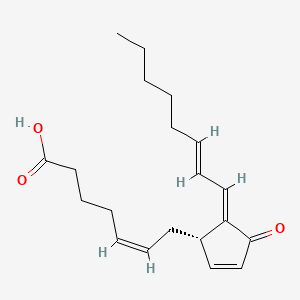
|
15-deoxy-delta-12,14-PGJ2 |
15-deoxy-delta-12,14-pgj2 is a lipid of Fatty Acyls (FA) class. 15-deoxy-delta-12,14-pgj2 is associated with abnormalities such as Dehydration and Myocardial Ischemia. The involved functions are known as Binding (Molecular Function), Inflammation, Alveolar ventilation function, Stimulus and Process. 15-deoxy-delta-12,14-pgj2 often locates in Cytosol, Myocardial tissue and Heart tissue. The associated genes with 15-deoxy-delta-12,14-PGJ2 are Homologous Gene and G-substrate. The related lipids are 15-deoxyprostaglandin J2 and Lipopolysaccharides. |
1201 |
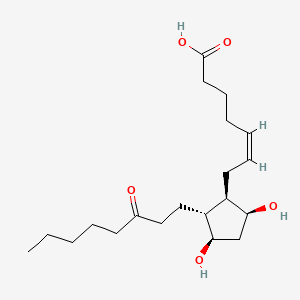
|
13,14-dihydro-15-keto-PGF2alpha |
13,14-dihydro-15-keto-pgf2alpha is a lipid of Fatty Acyls (FA) class. |
1147 |
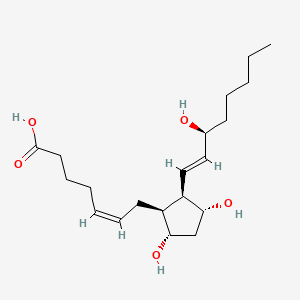
|
15-F2t-IsoP |
15-f2t-isop is a lipid of Fatty Acyls (FA) class. 15-f2t-isop is associated with abnormalities such as Diabetes Mellitus, Acute coronary syndrome, Risk factor, cardiovascular, thrombocytosis and Chronic ischemic heart disease NOS. The involved functions are known as Anabolism, Inflammation, Lipid Peroxidation, Excretory function and Platelet Activation. The associated genes with 15-F2t-IsoP are PTGS2 gene. |
2120 |

|
11beta-PGF2 |
11beta-pgf2 is a lipid of Fatty Acyls (FA) class. |
15009 |
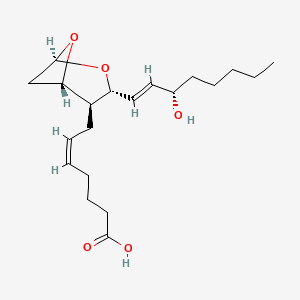
|
Thromboxane a2 |
Thromboxane a2 is a lipid of Fatty Acyls (FA) class. Thromboxane a2 is associated with abnormalities such as Asthma, Cardiovascular Diseases, Pulmonary Eosinophilia, ASPIRIN SENSITIVITY and Pneumonia. The involved functions are known as Signal Transduction, paracrine, Binding (Molecular Function), Platelet Activation and Inflammation. Thromboxane a2 often locates in Cell surface, Body tissue, Cell membrane, Blood and Extracellular. The associated genes with Thromboxane a2 are PTPRC gene, ESAM gene and PPBP gene. |
4534 |

|
Thromboxane b2 |
Thromboxane b2 is a lipid of Fatty Acyls (FA) class. Thromboxane b2 is associated with abnormalities such as endothelial dysfunction, Diabetes Mellitus, Non-Insulin-Dependent, Diabetes Mellitus, Ischemia and Thrombocytosis. The involved functions are known as Platelet Activation, Excretory function, Anabolism, Inflammation and mRNA Expression. Thromboxane b2 often locates in Endothelium, Hepatic and Microsomes, Liver. The associated genes with Thromboxane b2 are PTGS2 gene, prothrombin fragment 2 and CCL14 wt Allele. |
10175 |
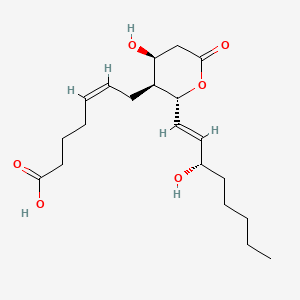
|
11-dehydro-TXB2 |
11-dehydro-txb2 is a lipid of Fatty Acyls (FA) class. 11-dehydro-txb2 is associated with abnormalities such as endothelial dysfunction, Risk factor, cardiovascular, Acute coronary syndrome, thrombocytosis and Chronic ischemic heart disease NOS. The involved functions are known as Platelet Activation, Excretory function, Anabolism, Inflammation and Lipid Peroxidation. The associated genes with 11-dehydro-TXB2 are PTGS2 gene. |
381 |
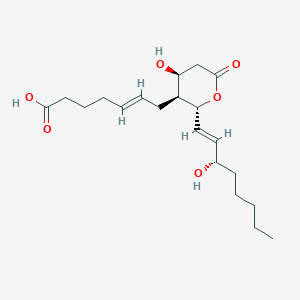
|
11-dehydro-txb2 |
|
98 |
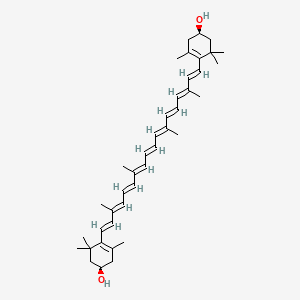
|
Zeaxanthin |
Zeaxanthin is a lipid of Prenol Lipids (PR) class. Zeaxanthin is associated with abnormalities such as Disintegration (morphologic abnormality), Alkalemia, Age related macular degeneration, Visual impairment and Consumption-archaic term for TB. The involved functions are known as Signal, Regulation, Energy Transfer, Process and Pigment. Zeaxanthin often locates in Chloroplast thylakoids, reaction center, Tissue membrane, PSII associated light-harvesting complex II and Thylakoid Membrane. The associated genes with Zeaxanthin are PRB2 gene, Structural gene, Polypeptides, Genes, Bacterial and Genes, rRNA. The related lipids are Membrane Lipids, Micelles, Fatty Acids, Lipid Peroxides and monogalactosyldiacylglycerol. The related experimental models are Knock-out. |
1769 |

|
Anandamide |
Anandamide is a lipid of Fatty Acyls (FA) class. Anandamide is associated with abnormalities such as Dehydration. The involved functions are known as Process, Phenomenon, Phosphorylation, Catabolic Process and Gene Expression. Anandamide often locates in Nuchal region, Microglial and Hepatic. The associated genes with Anandamide are SGPL1 gene, SPTLC1 gene, RPSA gene, KDSR gene and SMPD1 gene. The related lipids are Sphingolipids, Lipopolysaccharides, Lysophospholipids, LYSO-PC and lysophosphatidylethanolamine. |
4747 |
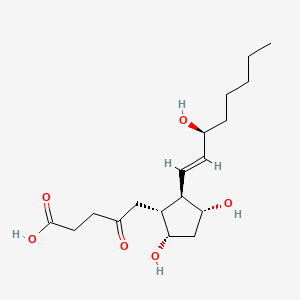
|
2,3-dinor, 6-keto-PGF1alpha |
2,3-dinor, 6-keto-pgf1alpha is a lipid of Fatty Acyls (FA) class. |
347 |
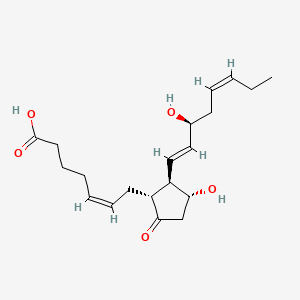
|
PGE3 |
Pge3 is a lipid of Fatty Acyls (FA) class. |
125 |
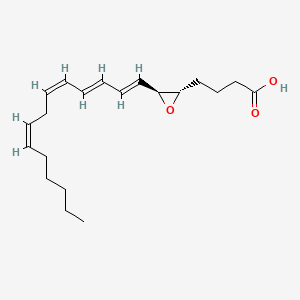
|
LTA4 |
Lta4 is a lipid of Fatty Acyls (FA) class. Lta4 is associated with abnormalities such as Myocardial Infarction. The involved functions are known as enzyme activity, Mutation, Lipid Binding, Neutrophil Activation and Inflammation. Lta4 often locates in Membrane, Extracellular and Cytosol. The associated genes with LTA4 are Locus, ALOX5AP gene, CIITA gene and TNFSF4 gene. The related lipids are Lipopolysaccharides. |
526 |
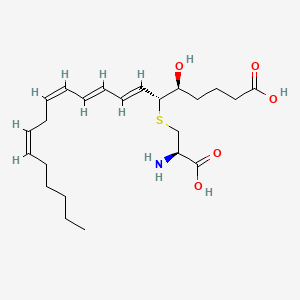
|
LTE4 |
Lte4 is a lipid of Fatty Acyls (FA) class. Lte4 is associated with abnormalities such as Asthma, Lung diseases, Eosinophilia, Respiration Disorders and Rhinitis. The involved functions are known as Anabolism, Increased Sensitivy, Process, Pathogenesis and Stimulus. Lte4 often locates in Membrane, Smooth muscle (tissue), Body tissue, Extracellular and Mucous Membrane. The associated genes with LTE4 are cystinylglycylglycine, FPR1 gene, PECAM1 gene, CCL3L1 gene and IL3 gene. |
1546 |
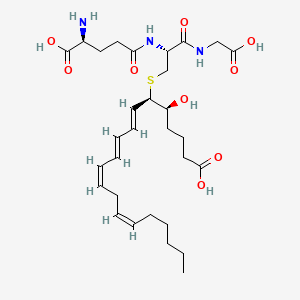
|
LTC4 |
Ltc4 is a lipid of Fatty Acyls (FA) class. Ltc4 is associated with abnormalities such as Asthma, Eosinophilia, Pulmonary Eosinophilia, Pneumonia and Cardiovascular Diseases. The involved functions are known as Signal, Gene Expression, Stimulus, Signal Transduction and Metabolic Inhibition. Ltc4 often locates in Plasma membrane, Cytoplasm, Back, Cytoplasmic and Tissue membrane. The associated genes with LTC4 are STIM1 gene, ABCC2 gene, CD9 gene, Mutant Proteins and Amino Acids, Aromatic. The related lipids are glycolithocholate. |
2252 |
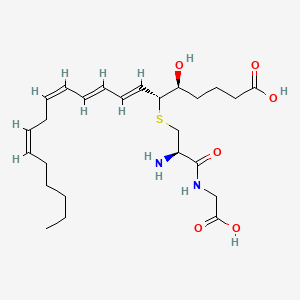
|
LTD4 |
Ltd4 is a lipid of Fatty Acyls (FA) class. Ltd4 is associated with abnormalities such as Inflammatory Bowel Diseases, Inflammatory disorder, Asthma, Pneumonia and Allergic asthma. The involved functions are known as inhibitors, Signal Transduction, Cell Survival, antagonists and Phosphorylation. Ltd4 often locates in Membrane, Tissue membrane, Protoplasm, Cytoplasmic matrix and membrane fraction. The associated genes with LTD4 are ALOX5 gene, UMOD gene, P4HTM gene, RAF1 gene and Homologous Gene. The related lipids are Lipopolysaccharides. |
1167 |
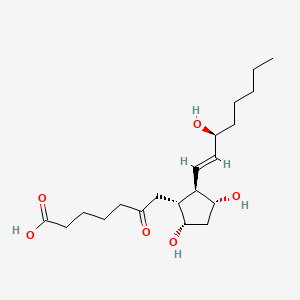
|
6-keto-pgf1alpha |
6-keto-pgf1alpha is a lipid of Fatty Acyls (FA) class. |
3430 |
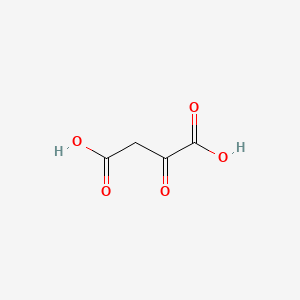
|
Oxalacetic acid |
Oxalacetic acid is a lipid of Fatty Acyls (FA) class. |
3226 |
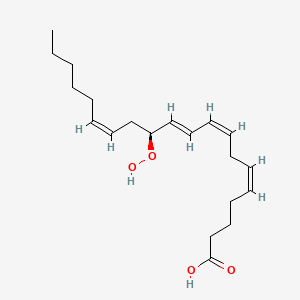
|
12S-HpETE |
12s-hpete is a lipid of Fatty Acyls (FA) class. |
211 |
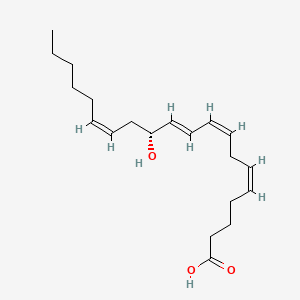
|
12(r)-hete |
12(r)-hete is a lipid of Fatty Acyls (FA) class. |
1079 |
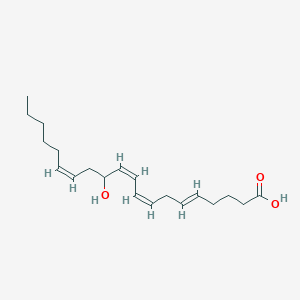
|
12-hete |
12-hete is a lipid of Fatty Acyls (FA) class. |
1452 |
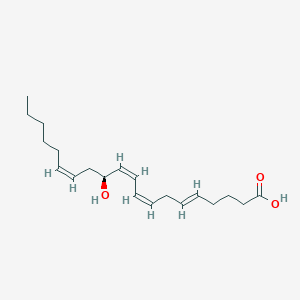
|
12-hydroxyeicosatetraenoic acid |
12-hydroxyeicosatetraenoic acid is a lipid of Fatty Acyls (FA) class. 12-hydroxyeicosatetraenoic acid is associated with abnormalities such as Endothelial dysfunction, Stable angina, Diabetes and Ischemia. The involved functions are known as Inflammation, Protective Agents, inhibitors, Signal Transduction and Extravasation. 12-hydroxyeicosatetraenoic acid often locates in Endothelium, Integumentary system, Articular system, Tissue fiber and Knee. The related lipids are 9-hydroxy-10,12-octadecadienoic acid, 13-hydroperoxy-9,11-octadecadienoic acid, hydroxy fatty acid and DOPE. |
1073 |
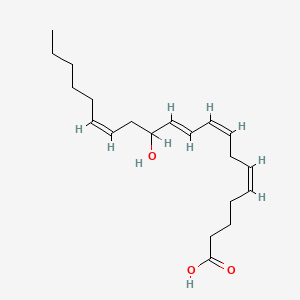
|
12-HETE |
12-HETE is a lipid of Fatty Acyls (FA) class. 12-HETE is associated with abnormalities such as Endothelial dysfunction, Stable angina, Diabetes and Ischemia. The involved functions are known as Inflammation, Protective Agents, Exocytosis, inhibitors and Signal Transduction. 12-HETE often locates in Endothelium, Integumentary system, Articular system, Tissue fiber and Knee. The related lipids are 9-hydroxy-10,12-octadecadienoic acid, 13-hydroperoxy-9,11-octadecadienoic acid, hydroxy fatty acid and DOPE. |
1073 |

|
4-hydroxynonenal |
4-hydroxynonenal is a lipid of Fatty Acyls (FA) class. 4-hydroxynonenal is associated with abnormalities such as Chronic disease, Obesity, Diabetes, Acquired Immunodeficiency Syndrome and Lung diseases. The involved functions are known as protein expression, Glycolysis, mRNA Expression, Regulation and Mitochondrion in division. 4-hydroxynonenal often locates in Muscle, Mitochondria, Adipose tissue, Head and Mouse Muscle. The associated genes with 4-hydroxynonenal are STAT3 gene, SIRT1 gene, PGC gene, IL6 gene and cytochrome c''. The related lipids are Lipopolysaccharides, Lipid Peroxides, Promega, Membrane Lipids and oxidized lipid. The related experimental models are Mouse Model, Knock-out, Transgenic Model, Disease model and Rodent Model. |
5685 |
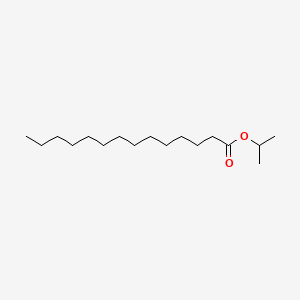
|
Isopropyl myristate |
Isopropyl myristate is a lipid of Fatty Acyls (FA) class. |
689 |
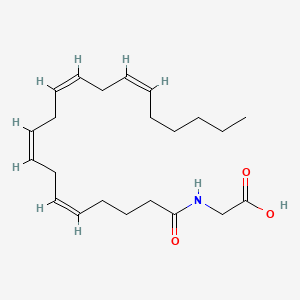
|
N-arachidonoyl glycine |
N-arachidonoyl glycine is a lipid of Fatty Acyls (FA) class. The involved functions are known as synergism. N-arachidonoyl glycine often locates in Microglial and Nuchal region. The associated genes with N-arachidonoyl glycine are LPAR5 gene and LPAR4 gene. |
112 |
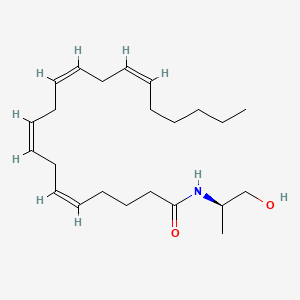
|
N-(1R-methyl-2-hydroxy-ethyl) arachidonoyl amine |
N-(1r-methyl-2-hydroxy-ethyl) arachidonoyl amine is a lipid of Fatty Acyls (FA) class. |
457 |
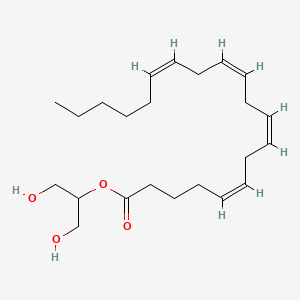
|
2-arachidonoylglycerol |
2-arachidonoylglycerol is a lipid of Glycerolipids (GL) class. 2-arachidonoylglycerol is associated with abnormalities such as Atherosclerosis, Heart Diseases, Inflammatory disorder, Colitis and Peripheral Neuropathy. The involved functions are known as Immunoreactivity, inhibitors, Stimulus, Esthesia and Signal Transduction. 2-arachidonoylglycerol often locates in Back, Presynaptic Terminals, Brain region, Blood and Body tissue. The associated genes with 2-arachidonoylglycerol are ADRBK1 gene, Homologous Gene, MGLL gene, PLA2G4A gene and peptide V. The related lipids are oleoylethanolamide, Lipopolysaccharides, Promega, stearic acid and 1-stearoyl-2-arachidonoylglycerol. The related experimental models are Knock-out. |
1892 |
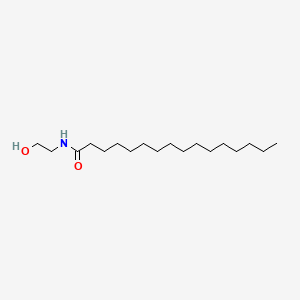
|
Palmitoyl-EA |
Palmitoyl-ea is a lipid of Fatty Acyls (FA) class. The involved functions are known as Cytokinesis of the fertilized ovum and phosphatase activity. The related lipids are stearic acid. |
1001 |
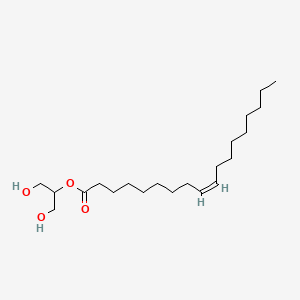
|
2-Monoolein |
2-Monoolein is a lipid of Glycerolipids (GL) class. The involved functions are known as Regulation, Binding (Molecular Function), Cytokinesis of the fertilized ovum, Signal Transduction and Drug Interactions. 2-monoolein often locates in Extracellular, Brain region, Membrane, Body tissue and Protoplasm. The associated genes with 2-Monoolein are Glucagon-Like Peptide 1, Homologous Gene, LIPG gene and Serum Albumin. The related lipids are oleoylethanolamide, stearoylethanolamide, Fatty Acids, Nonesterified, Fatty Acids, Unsaturated and linoleoyl ethanolamide. The related experimental models are Knock-out. |
48 |

|
(e,e,e,e)-squalene |
(e,e,e,e)-squalene is a lipid of Fatty Acyls (FA) class. (e,e,e,e)-squalene is associated with abnormalities such as Hypercholesterolemia and Cataract. The involved functions are known as Process, metaplastic cell transformation, Protein Overexpression, Anabolism and Biosynthetic Pathways. (e,e,e,e)-squalene often locates in Membrane, Protoplasm, Plasma membrane, Tissue membrane and Back. The associated genes with (e,e,e,e)-squalene are Genome, IMPACT gene, GAPDH gene, GTF2I gene and Chromatin. The related lipids are Membrane Lipids, cycloartenol, Sterols, Fatty Acids and Nonesterified Fatty Acids. |
1766 |

|
Platelet activating factor |
Platelet activating factor is a lipid of Glycerophospholipids (GP) class. Platelet activating factor is associated with abnormalities such as Atherosclerosis, Acute cholecystitis without calculus, Cholecystitis, Colitis and Cholecystitis, Acute. The involved functions are known as Cell Survival, Metabolic Inhibition, lipid oxidation, Apoptosis and Oxidation. Platelet activating factor often locates in soluble, Cellular Membrane, Smooth muscle (tissue), Intima and Tissue specimen. The associated genes with Platelet activating factor are apolipoprotein A-I Milano, Homologous Gene, TSPO gene, HBEGF gene and SLC33A1 gene. The related lipids are Hydroxycholesterols, Liposomes, 25-hydroxycholesterol, Lysophosphatidylcholines and Lipopolysaccharides. The related experimental models are Knock-out, Mouse Model and Transgenic Model. |
7383 |
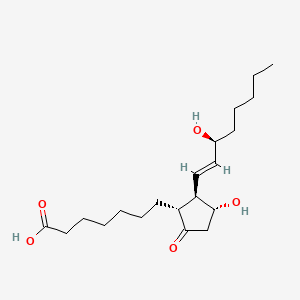
|
Prostaglandin e1 |
Prostaglandin e1 is a lipid of Fatty Acyls (FA) class. The involved functions are known as Protein Expression and Down-Regulation. |
5126 |

|
Ginkgolide B |
Ginkgolide b is a lipid of Prenol Lipids (PR) class. Ginkgolide b is associated with abnormalities such as Hyperostosis, Diffuse Idiopathic Skeletal. The involved functions are known as Embryonic Development, Caspase Activation, Apoptosis, DNA Fragmentation and Signal Transduction. Ginkgolide b often locates in Protoplasm and Mitochondria. The associated genes with Ginkgolide B are ESTERASE C, STAT3 gene, IMPACT gene, Prions and N-formylmethionyl-leucyl-phenylalanine. |
790 |

|
1-Oleoyl Lysophosphatidic Acid |
1-Oleoyl Lysophosphatidic Acid is a lipid of Glycerophospholipids (GP) class. 1-oleoyl lysophosphatidic acid is associated with abnormalities such as Myocardial Infarction, early pregnancy, Scleroderma, Blind Vision and Hyperlipidemia. The involved functions are known as Agent, Blood coagulation, Selection, Genetic, Analyte and Biological Processes. 1-oleoyl lysophosphatidic acid often locates in Tissue specimen, Body tissue, Blood, Membrane and Skin. The associated genes with 1-Oleoyl Lysophosphatidic Acid are Mucin-16, Peptides, SMAD4 gene, RND1 gene and Polypeptides. The related lipids are lysophosphatidic acid, A(2)C, Lysophospholipids, Fatty Acids and sphingosine 1-phosphate. The related experimental models are Mouse Model, Knock-out, Cancer Model, Xenograft Model and Arthritis, Adjuvant-Induced. |
3463 |

|
lysophosphatidic acid |
lysophosphatidic acid is a lipid of Glycerophospholipids (GP) class. Lysophosphatidic acid is associated with abnormalities such as Atherosclerosis, Alzheimer's Disease, Asthma, Diabetes Mellitus, Non-Insulin-Dependent and Septicemia. The involved functions are known as Inflammation, Chemotaxis, Binding (Molecular Function), Polymerization and Inflammatory Response. Lysophosphatidic acid often locates in Cytoskeleton, Microfilaments, actin cytoskeleton, Extracellular and Structure of germinal center of lymph node. The associated genes with lysophosphatidic acid are TNF gene, MAPK3 gene, RHOA gene, CDC42 gene and ADRBK1 gene. The related lipids are lysophosphatidic acid, Lipopolysaccharides, Lysophosphatidylcholines, Lysophospholipids and Phosphatidic Acid. The related experimental models are Knock-out, Transgenic Model, Rodent Model and Disease model. |
820 |

|
trichostatin A |
Trichostatin is a lipid of Polyketides (PK) class. Trichostatin is associated with abnormalities such as Dentatorubral-Pallidoluysian Atrophy, PARAGANGLIOMAS 3, abnormal fragmented structure, Disintegration (morphologic abnormality) and Hyperostosis, Diffuse Idiopathic Skeletal. The involved functions are known as Acetylation, Cell Differentiation process, histone modification, Gene Silencing and Transcriptional Activation. Trichostatin often locates in CD41a, Hematopoietic System, Chromatin Structure, Blood and Endothelium. The associated genes with Trichostatin are SPI1 gene, CELL Gene, Chromatin, CXCR4 gene and DNMT1 gene. The related lipids are Butyrates, Promega, butyrate, Lipopolysaccharides and Steroids. The related experimental models are Knock-out, Mouse Model, Xenograft Model and Cancer Model. |
5401 |

|
tacrolimus |
Tacrolimus is a lipid of Polyketides (PK) class. Tacrolimus is associated with abnormalities such as Renal glomerular disease. The involved functions are known as inhibitors, Fungicidal activity, Metabolic Inhibition, Excretory function and Dephosphorylation. Tacrolimus often locates in Hepatic, Mitochondrial matrix and Inner mitochondrial membrane. The associated genes with Tacrolimus are RHOA gene and BGN gene. |
12730 |

|
erythromycin |
erythromycin is a lipid of Polyketides (PK) class. Erythromycin is associated with abnormalities such as Systemic Inflammatory Response Syndrome, Pneumonia, Infection, Pneumococcal Infections and Exanthema. The involved functions are known as Pharmacodynamics, Sterility, Agent, Drug Kinetics and Adjudication. Erythromycin often locates in Blood, peritoneal, Extracellular, Ribosomes and apicoplast. The associated genes with erythromycin are P4HTM gene, SLC33A1 gene, FAM3B gene, Operon and Homologous Gene. The related lipids are Hydroxytestosterones, Steroids, Propionate, Mycolic Acids and campesterol. The related experimental models are Mouse Model and Knock-out. |
19871 |

|
Azithramycine |
Azithramycine is a lipid of Polyketides (PK) class. Azithramycine is associated with abnormalities such as Respiratory Tract Infections, Pneumonia, Lower respiratory tract infection, Infection and Nonspecific urethritis. The involved functions are known as Lysis, Selection, Genetic, Mutation, Relapse and Adaptation. Azithramycine often locates in Blood, Respiratory System, Genitourinary system, Back and Chest. The associated genes with Azithramycine are Genes, rRNA, Genome, RPL22 gene, OPRM1 gene and tryptic soy broth. The related lipids are Liposomes, Phosphatidylserines, Promega, Lipopolysaccharides and Steroids. The related experimental models are Mouse Model, Knock-out and Tissue Model. |
7835 |
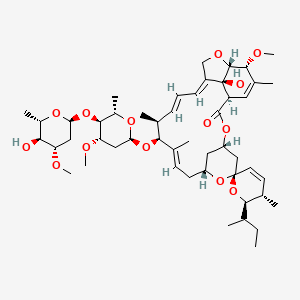
|
Avermectin A1a |
Avermectin A1a is a lipid of Polyketides (PK) class. Avermectin a1a is associated with abnormalities such as Ataxia with vitamin E deficiency, Strongyloidiasis, Congenital Transposition, Gigantism and Onchocerciasis. The involved functions are known as DNA Binding, Anabolism, Insertion Mutation, Process and physiological aspects. Avermectin a1a often locates in Chromosomes, Membrane, Clone, soluble and Tissue membrane. The associated genes with Avermectin A1a are Polypeptides, oxytocin, 1-desamino-(O-Et-Tyr)(2)-, Gene Feature, Genome and Gene Clusters. The related lipids are Propionate. The related experimental models are Mouse Model. |
765 |

|
nystatin |
nystatin is a lipid of Polyketides (PK) class. Nystatin is associated with abnormalities such as Virus Diseases, Infection, Candidiasis, Leukopenia and Mycoses. The involved functions are known as Membrane Potentials, Uptake, Flow or discharge, Cell membrane potential and adenine transport. Nystatin often locates in Cell Wall, Plasma membrane, Extracellular, Membrane and Virion. The associated genes with nystatin are Genome, Integral Membrane Proteins, Amino Acids, Basic, P4HTM gene and Homologous Gene. The related lipids are Sterols, Liposomes, Membrane Lipids, Sphingolipids and 1,2-oleoylphosphatidylcholine. The related experimental models are Knock-out and Xenograft Model. |
4890 |

|
minocycline |
minocycline is a lipid of Polyketides (PK) class. Minocycline is associated with abnormalities such as Infection, Soft Tissue Infections, Septicemia, Chronic hyponatremia and Lesion of brain. The involved functions are known as Pharmacodynamics, Gene Expression, Transcriptional Activation, Regulation and Process. Minocycline often locates in Ribosomes, 50S ribosomal subunit, Blood, Skin and Immune system. The associated genes with minocycline are THEMIS gene, KCNK2 gene, RBFOX3 gene, PIWIL2 gene and P4HTM gene. The related lipids are Lipopolysaccharides, Promega, Steroids, Liposomes and Octanols. The related experimental models are Mouse Model, Experimental Autoimmune Encephalomyelitis, Genetically Engineered Mouse, Disease model and spinal model. |
9780 |
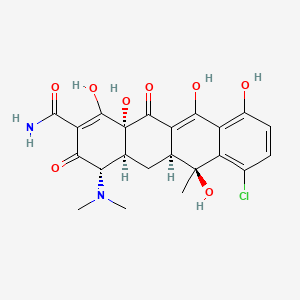
|
chlortetracycline |
chlortetracycline is a lipid of Polyketides (PK) class. Chlortetracycline is associated with abnormalities such as Granulomatous Disease, Chronic, Infection, Ischemia, Cerebral Ischemia and Cerebral Infarction. The involved functions are known as Regulation, Binding (Molecular Function), Agent, Stimulus and Process. Chlortetracycline often locates in Protoplasm, Plasma membrane, Membrane, Cytoplasm and specific granule. The associated genes with chlortetracycline are FPR1 gene, P4HTM gene, Homologous Gene, HIST1H1C gene and Microbiome. The related lipids are Lysophosphatidylcholines, Sterols, dilauroyl lecithin, seminolipid and Total cholesterol. The related experimental models are Mouse Model. |
6144 |

|
CYTOCHALASIN B |
CYTOCHALASIN B is a lipid of Polyketides (PK) class. Cytochalasin b is associated with abnormalities such as Renal tubular disorder and Chagas Disease. The involved functions are known as Membrane Protein Traffic, inhibitors, Metabolic Inhibition, Biochemical Pathway and Increased Sensitivy. Cytochalasin b often locates in Cytoplasmic matrix, Plasma membrane, Microtubules, Extracellular and Protoplasm. The associated genes with CYTOCHALASIN B are SLC2A2 gene, PFDN5 gene, SLC2A1 gene, OMG gene and SPEN gene. The related lipids are Steroids, Lipopolysaccharides and Liposomes. The related experimental models are Xenograft Model. |
9648 |

|
(-)-Epigallocatechin gallate |
(-)-Epigallocatechin gallate is a lipid of Polyketides (PK) class. (-)-epigallocatechin gallate is associated with abnormalities such as IMMUNE SUPPRESSION, Infection, Nodule, Lymphopenia and Tumor Immunity. The involved functions are known as Apoptosis, Cellular Immune Response, Specific immune response, Signal and Infiltration. (-)-epigallocatechin gallate often locates in Immune system, Cytoplasmic Granules, Skin, Protoplasm and Body tissue. The associated genes with (-)-Epigallocatechin gallate are C8orf4 gene, Genes, vpr, MAPK8 gene, P4HTM gene and GAG Gene. The related lipids are Promega, Lipopolysaccharides, Palmitates, Fatty Acids and Sphingolipids. The related experimental models are Mouse Model, Xenograft Model, Transgenic Model, Experimental Autoimmune Encephalomyelitis and Arthritis, Collagen-Induced. |
6551 |

|
SCHEMBL105486 |
Kakonein is a lipid of Polyketides (PK) class. Kakonein is associated with abnormalities such as Fatty Liver, Chronic liver disease, Morphologically altered structure, Hypertensive disease and Cardiovascular Diseases. The involved functions are known as protein expression, Extravasation, Liver damage, mRNA Expression and cell activation. Kakonein often locates in Body tissue, Hepatic, Microvilli, Cytoplasm and Membrane. The associated genes with Kakonein are TJP1 gene, CD14 gene, iberiotoxin, AT-Rich Interactive Domain-Containing Protein 1A and NKS1 gene. The related lipids are dehydrosoyasaponin I and Steroids. The related experimental models are Knock-out. |
1391 |
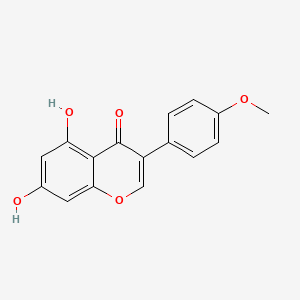
|
biochanin A |
Biochanin a is a lipid of Polyketides (PK) class. Biochanin a is associated with abnormalities such as Osteoporosis. The involved functions are known as Uptake, adenosinetriphosphatase activity, inhibitors, Drug Interactions and Metabolic Inhibition. Biochanin a often locates in Membrane, Tissue membrane, Microsomes, Microsomes, Liver and Entire oral cavity. The associated genes with Biochanin A are CD9 gene, SLCO1B1 gene, ABCG2 gene, EDNRB gene and SPAG8 gene. The related lipids are Steroids, Androstenols, Sphingolipids and 1,2-oleoylphosphatidylcholine. |
465 |

|
rotenone |
rotenone is a lipid of Polyketides (PK) class. Rotenone is associated with abnormalities such as Parkinson Disease, MYOPATHY, DISTAL, WITH ANTERIOR TIBIAL ONSET, Neurodegenerative Disorders, Septicemia and Respiratory Failure. The involved functions are known as Phosphorylation, Process, Cell Death, proteasome activity and Apoptosis. Rotenone often locates in Protoplasm, Presynaptic Terminals, Neurites, NADH dehydrogenase complex and Mitochondria. The associated genes with rotenone are DNAJB9 gene, EIF2S3 gene, Candidate Disease Gene, G-substrate and ERN1 gene. The related lipids are Lipopolysaccharides, Membrane Lipids, Phosphatidylserines, Fatty Acids and Cardiolipins. The related experimental models are Knock-out, Mouse Model, Disease model and Rodent Model. |
7079 |
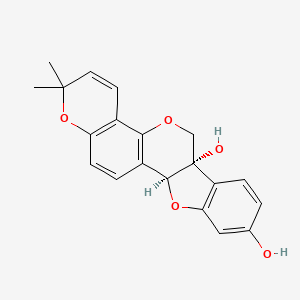
|
Glyceollin |
Glyceollin is a lipid of Polyketides (PK) class. Glyceollin is associated with abnormalities such as Malignant Carcinoid Syndrome, Infection, infection induced, Diabetes and Diabetes Mellitus, Non-Insulin-Dependent. The involved functions are known as Agent, Binding, Competitive, Signal Transduction, Gene Expression and Transcription, Genetic. Glyceollin often locates in Body tissue, Epithelium, viral nucleocapsid location, Membrane and Mouse Uterus. The associated genes with Glyceollin are CXCL12 wt Allele, PGR gene, Genes, Reporter, TFF1 gene and NGFR gene. The related experimental models are Xenograft Model. |
177 |
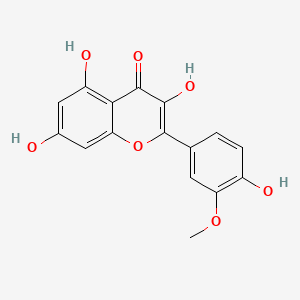
|
Isorhamnetin |
Isorhamnetin is a lipid of Polyketides (PK) class. Isorhamnetin is associated with abnormalities such as Facial Hemiatrophy, Colitis, endothelial dysfunction, Morphologically altered structure and Diabetes. The involved functions are known as enzyme activity, Methylation, Anabolism, Binding (Molecular Function) and Vmax. Isorhamnetin often locates in Body tissue, Cytoplasmic, Mucous Membrane, Cytoplasm and Human tissue. The associated genes with Isorhamnetin are CSK gene, RPS6KA3 gene, Mitogen-activated protein, NCF1 gene and Chromatin. The related lipids are Fatty Acids, Phosphatidylserines and Palmitates. The related experimental models are Mouse Model, Xenograft Model and Streptozotocin Diabetes. |
1015 |

|
quercetin |
quercetin is a lipid of Polyketides (PK) class. Quercetin is associated with abnormalities such as Coronary heart disease, Myocardial Infarction, Cirrhosis, Coronary Arteriosclerosis and Vascular ring. The involved functions are known as Vasodilation, physiological aspects, Fermentation, Process and Ingredient. Quercetin often locates in Arterial system, Endothelium, Skin, Endothelium, Vascular and Tissue specimen. The associated genes with quercetin are P4HTM gene, SULT gene, UGT1A1 gene, ARHGAP26 gene and PLXNB1 gene. The related lipids are blood lipid, Promega, Steroids, Phosphatidylserines and Fatty Acids. The related experimental models are Knock-out, Mouse Model, Xenograft Model, Tissue Model and Cancer Model. |
5377 |

|
apigenin |
apigenin is a lipid of Polyketides (PK) class. Apigenin is associated with abnormalities such as Morphologically altered structure, Chimera disorder, Hypertensive disease, infection induced and Infection. The involved functions are known as inhibitors, Gene Expression, Process, Metabolic Inhibition and Cell Death. Apigenin often locates in Vacuole, Cytoplasmic matrix, Cytoplasm, Tissue membrane and Membrane. The associated genes with apigenin are MSMP gene, BCL2 gene, PTGS2 gene, Chromatin and SLC33A1 gene. The related lipids are Lipopolysaccharides, Steroids, 1-Butanol, agosterol A and Butyrates. The related experimental models are Mouse Model, Tissue Model, Knock-out, Xenograft Model and Disease model. |
4250 |

|
luteolin |
luteolin is a lipid of Polyketides (PK) class. Luteolin is associated with abnormalities such as Morphologically altered structure, Nodule, retinal toxicity, CLEFT LIP, CONGENITAL HEALED and Ischemia. The involved functions are known as Metabolic Inhibition, Cell Death, Caspase Activation, activation of protein kinase C activity by G-protein coupled receptor protein signaling pathway and protein kinase C activity. Luteolin often locates in Mitochondria, Cell-Free System, Protoplasm, Membrane and Body tissue. The associated genes with luteolin are BCL2 gene, TNFSF10 gene, BCL2L1 gene, XIAP gene and MCL1 gene. The related lipids are Lipopolysaccharides, Sterols, blood lipid, Fatty Acids and Steroids. The related experimental models are Xenograft Model, Mouse Model, Experimental Autoimmune Encephalomyelitis, Knock-out and Cancer Model. |
3284 |
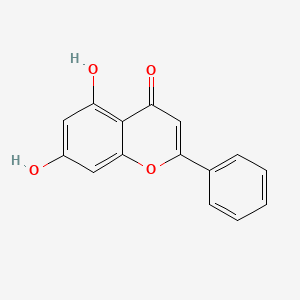
|
chrysin |
chrysin is a lipid of Polyketides (PK) class. Chrysin is associated with abnormalities such as Unconjugated hyperbilirubinemia, Metabolic Diseases, Hypogonadism, Renal tubular disorder and Colitis. The involved functions are known as Hypoxia, enzyme activity, Oxidation, inhibitors and Cell Survival. Chrysin often locates in Protoplasm, Plasma membrane, Back, Extracellular and Mitochondria. The associated genes with chrysin are CFB gene, P4HTM gene, UGT1A9 gene, CYP1A1 gene and UGT1A1 gene. The related lipids are Promega, estradiol-3-glucuronide, Steroids and Lipopolysaccharides. The related experimental models are Mouse Model. |
1085 |

|
baicalein |
baicalein is a lipid of Polyketides (PK) class. Baicalein is associated with abnormalities such as Neurodegenerative Disorders, Fibrillation, Hypertensive disease, Aortic coarctation and Coronary Occlusion. The involved functions are known as Anabolism, Polymerization, Process, inhibitors and Pathogenesis. Baicalein often locates in Membrane, Lipid Bilayers, soluble, Cell-Free System and Protoplasm. The associated genes with baicalein are P4HTM gene, BIRC5 gene, TSPO gene, SHOC2 gene and XIAP gene. The related lipids are Fatty Acids, Nonesterified Fatty Acids, iodoresiniferatoxin, Lipopolysaccharides and 17-octadecynoic acid. The related experimental models are Knock-out, Mouse Model and Parkinsonism, Experimental. |
1997 |



































































































